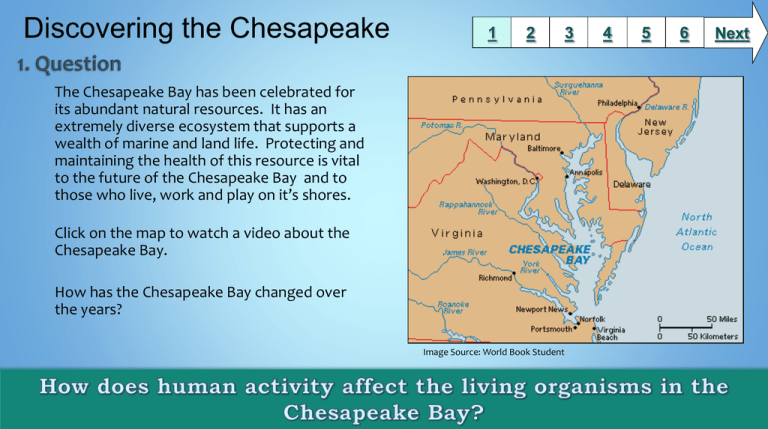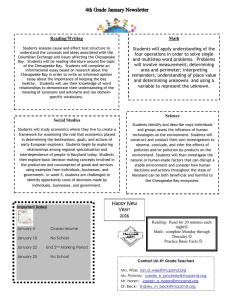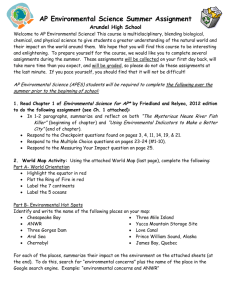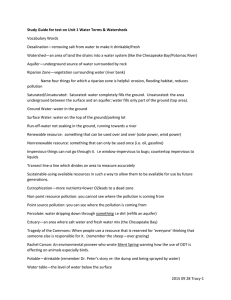
1
2
The Chesapeake Bay has been celebrated for
its abundant natural resources. It has an
extremely diverse ecosystem that supports a
wealth of marine and land life. Protecting and
maintaining the health of this resource is vital
to the future of the Chesapeake Bay and to
those who live, work and play on it’s shores.
Click on the map to watch a video about the
Chesapeake Bay.
How has the Chesapeake Bay changed over
the years?
Image Source: World Book Student
3
4
5
6
Next
1
2
3
4
5
Use the resources below to become an expert on one aspect of the
Chesapeake Bay Ecosystem as detailed on the next slide.
Bay Geology
Chemical
Makeup
Dissolved
Oxygen
The Estuary
System
Food Web
Physical
Characteristics
Life at the
Bottom
Water Clarity
NatureWorks is an article on bay ecosystems. You can click on the
ReadAloud button in the top right for an audio version of the article.
Image Source: Chesapeake Bay Program
6
Next
1
2
3
Each part of the ecosystem identified in
the previous page is integral to the
overall health of the Chesapeake Bay.
You will be assigned to a group and
asked to become an expert on one
element of the Chesapeake Bay’s
ecosystem.
Use the inquiry organizer to take notes.
Image Source: Chesapeake Bay Program
4
5
6
Next
1
2
3
Your group will use ActivInspire to
create a flipchart page to present your
information and summarize how you
think human activity has affected the
Chesapeake Bay’s ecosystem and living
organisms.
Your teacher may assign an alternative
product such as PowerPoint or Prezi.
Use this scoring tool to assess your flipchart
page.
Prezi scoring tool
PowerPoint scoring tool
Image Source: Chesapeake Bay Program
4
5
6
Next
1
Click on the image below to learn how
you can help the Chesapeake Bay.
2
3
4
5
Learn more about the Chesapeake Bay
Chesapeake Bay Foundation
Chesapeake Bay Program
Bay Journal
Department of Natural Resources
Fun and Interesting Activities
Gyotaku “Japanese Art of Fish Printing”
Bay Coloring Book
Bay Game
Career Connections
Department of Natural Resources
Chesapeake Bay Foundation
Image Source: Chesapeake Bay Foundation
6
Next
1
2
3
4
5
6
Time Frame:
BCPS Curriculum
Grade 3 Library Media Curriculum
Unit 6: Discovering the Chesapeake Bay
Common Core State Standards
Reading: 1. Read closely to determine what the text says explicitly and to make logical
inferences from it; cite specific textual evidence when writing or speaking to support
conclusions drawn from the text.
Writing: 7. Conduct short as well as more sustained research projects based on focused
questions, demonstrating understanding of the subject under investigation.
Standards for the 21st Century Learner
1.1.6 Read, view, and listen for information presented in any format (e.g. textual,
visual, media, digital) in order to make inferences and gather meaning.
2.1.3 Use strategies to draw conclusions from information and apply knowledge to
curricular areas, real-world situations, and further investigations.
Maryland Technology Literacy Standards for Students
3.0: Use a variety of technologies for learning and collaboration.
2 50 minute periods
Differentiation:
Direct students to use comprehension tools included in
databases, such as: audio read-aloud, labeled reading
levels, and embedded dictionaries.
Learning Styles:
Auditory, Visual, Kinesthetic, Reflective, Sequential, Field
Independent
Notes to the teacher:
Some activities may be used cross curricular, i.e, fish art
could be done during art class. Contact Chesapeake Bay
resources for possible virtual fieldtrip using Safari Live or
Skype.
If the Prezi product is chosen the teacher will need to create a
class account prior to beginning the project.
Last updated: July 2015
Created by Michael Le, Library Media Specialist
BCPS Slam Dunk Research Model, Copyright 2013, Baltimore County Public Schools, MD, all rights reserved. The models may be used for educational, non-profit school use only.
All other uses, transmissions, and duplications are prohibited unless permission is granted expressly. This lesson is based on Jamie McKenzie’s Slam Dunk Lesson module.




